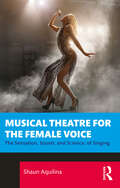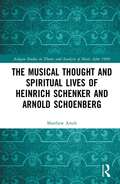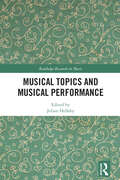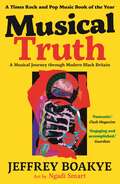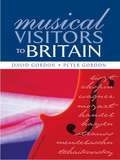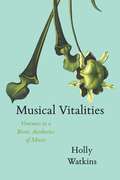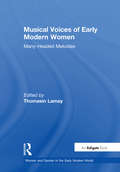- Table View
- List View
Musical Theatre For Dummies
by Seth RudetskyDiscover what goes on behind the curtains of your favorite musical Have you ever dreamed of being in a Broadway musical, or even just to be in the ensemble in your local community theatre? In Musical Theater For Dummies, Broadway insider and host of Sirus/XM Radio’s ON BROADWAY channel Seth Rudetsky takes you backstage and shows you what it takes to create a spectacular production. You’ll get the behind-the-curtain view of how your favorite on- and off-Broadway shows are made, plus get expert advice on how to launch your own career under the bright lights. If you’re new to musical theater, this book will initiate you into the world of musicals by sharing the stories and lingo that defines this fascinating world. This unique book shares insights into what makes musical theatre tick and how you can enjoy a show from your seat in the audience or from the stage itself. Learn the history of musical theater and discover the shows born on Broadway or the West End that became cultural phenomena Trace the development of productions, from the idea stage all the way through opening night and beyond Enjoy theater productions more, thanks to deep insights into how theater is made Get insider advice on the skills you need to perform in professional or amateur musical theater productions Real-life anecdotes and excellent show recommendations will entertain and delight you as you become a musical theater know-it-all, with Dummies.
Musical Theatre For Dummies
by Seth RudetskyDiscover what goes on behind the curtains of your favorite musical Have you ever dreamed of being in a Broadway musical, or even just to be in the ensemble in your local community theatre? In Musical Theater For Dummies, Broadway insider and host of Sirus/XM Radio’s ON BROADWAY channel Seth Rudetsky takes you backstage and shows you what it takes to create a spectacular production. You’ll get the behind-the-curtain view of how your favorite on- and off-Broadway shows are made, plus get expert advice on how to launch your own career under the bright lights. If you’re new to musical theater, this book will initiate you into the world of musicals by sharing the stories and lingo that defines this fascinating world. This unique book shares insights into what makes musical theatre tick and how you can enjoy a show from your seat in the audience or from the stage itself. Learn the history of musical theater and discover the shows born on Broadway or the West End that became cultural phenomena Trace the development of productions, from the idea stage all the way through opening night and beyond Enjoy theater productions more, thanks to deep insights into how theater is made Get insider advice on the skills you need to perform in professional or amateur musical theater productions Real-life anecdotes and excellent show recommendations will entertain and delight you as you become a musical theater know-it-all, with Dummies.
Musical Theatre for the Female Voice: The Sensation, Sound, and Science, of Singing
by Shaun AquilinaFemale musical theatre singers produce some of the most exciting and expressive singing an audience can experience. They also face a unique and specific set of issues when approaching their craft, from negotiating the registers of their voice to enable them to belt, to vocal health challenges such as premenstrual voice syndrome. This is the only book that offers a full and detailed guide to tackling those issues and to singing with full expression and technical excellence. Musical Theatre for the Female Voice covers the origin of singing in musicals, from the bel canto style of 300 years ago through to the latest developments in high belting, in shows such as Wicked and Waitress. It offers the reader exercises and methods that have been used to train hundreds of singers at some of the UK’s leading musical theatre training institutions and are underpinned by the latest academic research in journals on singing, psychology, and health. Every element of a singer's toolkit is covered from a female perspective, from breath and posture to character work and vocal health. This is an essential guidebook for female singers in musical theatre productions, either training at university or conservatory level or forging a career as professional triple-threat performers.
Musical Theatre for the Female Voice: The Sensation, Sound, and Science, of Singing
by Shaun AquilinaFemale musical theatre singers produce some of the most exciting and expressive singing an audience can experience. They also face a unique and specific set of issues when approaching their craft, from negotiating the registers of their voice to enable them to belt, to vocal health challenges such as premenstrual voice syndrome. This is the only book that offers a full and detailed guide to tackling those issues and to singing with full expression and technical excellence. Musical Theatre for the Female Voice covers the origin of singing in musicals, from the bel canto style of 300 years ago through to the latest developments in high belting, in shows such as Wicked and Waitress. It offers the reader exercises and methods that have been used to train hundreds of singers at some of the UK’s leading musical theatre training institutions and are underpinned by the latest academic research in journals on singing, psychology, and health. Every element of a singer's toolkit is covered from a female perspective, from breath and posture to character work and vocal health. This is an essential guidebook for female singers in musical theatre productions, either training at university or conservatory level or forging a career as professional triple-threat performers.
Musical Theatre, Realism and Entertainment (Ashgate Interdisciplinary Studies in Opera)
by Millie TaylorWhat is it about musical theatre that audiences find entertaining? What are the features that lead to its ability to stimulate emotional attachment, to move and to give pleasure? Beginning from the passion musical theatre performances arouse and their ubiquity in London's West End and on Broadway this book explores the ways in which musical theatre reaches out to and involves its audiences. It investigates how pleasure is stimulated by vocal, musical and spectacular performances. Early discussions centre on the construction of the composed text, but then attention is given to performance and audience response. Musical theatre contains disruptions and dissonances in its multiple texts, it allows gaps for audiences to read playfully. This combines with the voluptuous sensations of embodied emotion, contagiously and viscerally shared between audience and stage, and augmented through the presence of voice and music. A number of features are discovered in the construction of musical theatre performance texts that allow them to engage the intense emotional attachment of their audiences and so achieve enormous popularity. In doing this, the book challenges the conception of musical theatre as 'only entertainment'. Entertainment instead becomes a desirable, ephemeral and playful concept.
Musical Theatre, Realism and Entertainment (Ashgate Interdisciplinary Studies in Opera)
by Millie TaylorWhat is it about musical theatre that audiences find entertaining? What are the features that lead to its ability to stimulate emotional attachment, to move and to give pleasure? Beginning from the passion musical theatre performances arouse and their ubiquity in London's West End and on Broadway this book explores the ways in which musical theatre reaches out to and involves its audiences. It investigates how pleasure is stimulated by vocal, musical and spectacular performances. Early discussions centre on the construction of the composed text, but then attention is given to performance and audience response. Musical theatre contains disruptions and dissonances in its multiple texts, it allows gaps for audiences to read playfully. This combines with the voluptuous sensations of embodied emotion, contagiously and viscerally shared between audience and stage, and augmented through the presence of voice and music. A number of features are discovered in the construction of musical theatre performance texts that allow them to engage the intense emotional attachment of their audiences and so achieve enormous popularity. In doing this, the book challenges the conception of musical theatre as 'only entertainment'. Entertainment instead becomes a desirable, ephemeral and playful concept.
Musical Theory in the Renaissance
by Cristle Collins JuddThis volume of essays draws together recent work on historical music theory of the Renaissance. The collection spans the major themes addressed by Renaissance writers on music and highlights the differing approaches to this body of work by modern scholars, including: historical and theoretical perspectives; consideration of the broader cultural context for writing about music in the Renaissance; and the dissemination of such work. Selected from a variety of sources ranging from journals, monographs and specialist edited volumes, to critical editions, translations and facsimiles, these previously published articles reflect a broad chronological and geographical span, and consider Renaissance sources that range from the overtly pedagogical to the highly speculative. Taken together, this collection enables consideration of key essays side by side aided by the editor‘s introductory essay which highlights ongoing debates and offers a general framework for interpreting past and future directions in the study of historical music theory from the Renaissance.
Musical Theory in the Renaissance
by CristleCollins JuddThis volume of essays draws together recent work on historical music theory of the Renaissance. The collection spans the major themes addressed by Renaissance writers on music and highlights the differing approaches to this body of work by modern scholars, including: historical and theoretical perspectives; consideration of the broader cultural context for writing about music in the Renaissance; and the dissemination of such work. Selected from a variety of sources ranging from journals, monographs and specialist edited volumes, to critical editions, translations and facsimiles, these previously published articles reflect a broad chronological and geographical span, and consider Renaissance sources that range from the overtly pedagogical to the highly speculative. Taken together, this collection enables consideration of key essays side by side aided by the editor‘s introductory essay which highlights ongoing debates and offers a general framework for interpreting past and future directions in the study of historical music theory from the Renaissance.
The Musical Thought and Spiritual Lives of Heinrich Schenker and Arnold Schoenberg (Ashgate Studies in Theory and Analysis of Music After 1900)
by Matthew ArndtThis book examines the origin, content, and development of the musical thought of Heinrich Schenker and Arnold Schoenberg. One of the premises is that Schenker’s and Schoenberg’s inner musical lives are inseparable from their inner spiritual lives. Curiously, Schenker and Schoenberg start out in much the same musical-spiritual place, yet musically they split while spiritually they grow closer. The reception of Schenker’s and Schoenberg’s work has sidestepped this paradox of commonality and conflict, instead choosing to universalize and amplify their conflict. Bringing to light a trove of unpublished material, Arndt argues that Schenker’s and Schoenberg’s conflict is a reflection of tensions within their musical and spiritual ideas. They share a particular conception of the tone as an ideal sound realized in the spiritual eye of the genius. The tensions inherent in this largely psychological and material notion of the tone and this largely metaphysical notion of the genius shape both their musical divergence on the logical (technical) level in theory and composition, including their advocacy of the Ursatz versus twelvetone composition, and their spiritual convergence, including their embrace of Judaism. These findings shed new light on the musical and philosophical worlds of Schenker and Schoenberg and on the profound artistic and spiritual questions with which they grapple.
The Musical Thought and Spiritual Lives of Heinrich Schenker and Arnold Schoenberg (Ashgate Studies in Theory and Analysis of Music After 1900)
by Matthew ArndtThis book examines the origin, content, and development of the musical thought of Heinrich Schenker and Arnold Schoenberg. One of the premises is that Schenker’s and Schoenberg’s inner musical lives are inseparable from their inner spiritual lives. Curiously, Schenker and Schoenberg start out in much the same musical-spiritual place, yet musically they split while spiritually they grow closer. The reception of Schenker’s and Schoenberg’s work has sidestepped this paradox of commonality and conflict, instead choosing to universalize and amplify their conflict. Bringing to light a trove of unpublished material, Arndt argues that Schenker’s and Schoenberg’s conflict is a reflection of tensions within their musical and spiritual ideas. They share a particular conception of the tone as an ideal sound realized in the spiritual eye of the genius. The tensions inherent in this largely psychological and material notion of the tone and this largely metaphysical notion of the genius shape both their musical divergence on the logical (technical) level in theory and composition, including their advocacy of the Ursatz versus twelvetone composition, and their spiritual convergence, including their embrace of Judaism. These findings shed new light on the musical and philosophical worlds of Schenker and Schoenberg and on the profound artistic and spiritual questions with which they grapple.
Musical Topics and Musical Performance (Routledge Research in Music)
by Julian HellabyThe principal purpose of topics in musicology has been to identify meaning-bearing units within a musical composition that would have been understood by contemporary audiences and therefore also by later receivers, albeit in a different context and with a need for historically aware listening. Since Leonard Ratner (1980) introduced the idea of topics, his relatively simple ideas have been expanded and developed by a number of distinguished authors. Topic theory has now become a well-established branch of musicology, often embracing semiotics, but its relationship to performance has received less attention. Musical Topics and Musical Performance thus focuses on the interface of theory and practice, and investigates how an appreciation of topical presence in a work may prompt interpretative thoughts for a potential performer as well as how performers have responded to such a presence in practice. The chapters focus on music from the nineteenth, twentieth and twenty-first centuries with case studies drawn from composers as diverse as Beethoven, Scriabin and Péter Eötvös. Using both scores and recordings, the book presents a variety of original and innovative perspectives on the subject from a range of distinguished authors, and addresses a neglected area of musicology and musical performance.
Musical Topics and Musical Performance (Routledge Research in Music)
by Julian HellabyThe principal purpose of topics in musicology has been to identify meaning-bearing units within a musical composition that would have been understood by contemporary audiences and therefore also by later receivers, albeit in a different context and with a need for historically aware listening. Since Leonard Ratner (1980) introduced the idea of topics, his relatively simple ideas have been expanded and developed by a number of distinguished authors. Topic theory has now become a well-established branch of musicology, often embracing semiotics, but its relationship to performance has received less attention. Musical Topics and Musical Performance thus focuses on the interface of theory and practice, and investigates how an appreciation of topical presence in a work may prompt interpretative thoughts for a potential performer as well as how performers have responded to such a presence in practice. The chapters focus on music from the nineteenth, twentieth and twenty-first centuries with case studies drawn from composers as diverse as Beethoven, Scriabin and Péter Eötvös. Using both scores and recordings, the book presents a variety of original and innovative perspectives on the subject from a range of distinguished authors, and addresses a neglected area of musicology and musical performance.
The Musical Traditions of Northern Ireland and its Diaspora: Community and Conflict
by David CooperFor at least two centuries, and arguably much longer, Ireland has exerted an important influence on the development of the traditional, popular and art musics of other regions, and in particular those of Britain and the United States. During the past decade or so, the traditional musics of the so-called Celtic regions have become a focus of international interest. The phenomenal success of shows such as Riverdance (which appeared in 1995, spawned from a 1994 Eurovision Song Contest interval act) brought Irish music and dance to a global audience and played a part in the further commoditization of Irish culture, including traditional music. However, there has been until now, relatively little serious musicological study of the traditional music of Northern Ireland. Northern Ireland remains a divided community in which traditional culture, in all its manifestations, is widely understood as a marker of religious affiliation and ethnic identity. Since the outbreak of the most recent 'troubles' around 1968, the borders between the communities have often been marked by music. For example, many in the Catholic, nationalist community, regard the music of Orange flute bands and Lambeg drums as a source of intimidation. Equally, many in the Protestant community have distanced themselves from Irish music as coming from a different ethnic tradition, and some have rejected tunes, styles and even instruments because of their association with the Catholic community and the Irish Republic. Of course, during the same period many other Protestants and Catholics have continued to perform in an apolitical context and often together, what in earlier times would simply have been regarded as folk or country music. With the increasing espousal of a discrete Ulster Scots tradition since the signing of the Belfast (or 'Good Friday') Agreement in 1998, the characteristics of the traditional music performed in Northern Ireland, and the place of Protestant musicians within popular Irish cult
The Musical Traditions of Northern Ireland and its Diaspora: Community and Conflict (Ashgate Popular And Folk Music Ser.)
by David CooperFor at least two centuries, and arguably much longer, Ireland has exerted an important influence on the development of the traditional, popular and art musics of other regions, and in particular those of Britain and the United States. During the past decade or so, the traditional musics of the so-called Celtic regions have become a focus of international interest. The phenomenal success of shows such as Riverdance (which appeared in 1995, spawned from a 1994 Eurovision Song Contest interval act) brought Irish music and dance to a global audience and played a part in the further commoditization of Irish culture, including traditional music. However, there has been until now, relatively little serious musicological study of the traditional music of Northern Ireland. Northern Ireland remains a divided community in which traditional culture, in all its manifestations, is widely understood as a marker of religious affiliation and ethnic identity. Since the outbreak of the most recent 'troubles' around 1968, the borders between the communities have often been marked by music. For example, many in the Catholic, nationalist community, regard the music of Orange flute bands and Lambeg drums as a source of intimidation. Equally, many in the Protestant community have distanced themselves from Irish music as coming from a different ethnic tradition, and some have rejected tunes, styles and even instruments because of their association with the Catholic community and the Irish Republic. Of course, during the same period many other Protestants and Catholics have continued to perform in an apolitical context and often together, what in earlier times would simply have been regarded as folk or country music. With the increasing espousal of a discrete Ulster Scots tradition since the signing of the Belfast (or 'Good Friday') Agreement in 1998, the characteristics of the traditional music performed in Northern Ireland, and the place of Protestant musicians within popular Irish cult
Musical Truth: A Musical History of Modern Black Britain in 28 Songs
by Jeffrey BoakyeMusic can carry the stories of history like a message in a bottle.Lord Kitchener, Neneh Cherry, Smiley Culture, Stormzy . . . Groundbreaking musicians whose songs have changed the world. But how? This exhilarating playlist tracks some of the key shifts in modern British history, and explores the emotional impact of 28 songs and the artists who performed them.This book redefines British history, the Empire and postcolonialism, and will invite you to think again about the narratives and key moments in history that you have been taught up to now.Thrilling, urgent, entertaining and thought-provoking, this beautifully illustrated companion to modern black music is a revelation and a delight.
Musical Visitors to Britain (Woburn Education Series)
by Peter GordonBritain has attracted many musical visitors to its shores. A varied and often eccentric collection of individuals, some were invited by royalty with musical tastes, some were refugees from religious or political oppression, some were spies, and others came to escape debt or even charges of murder. This book paints a broad picture of the changing nature of musical life in Britain over the centuries, through the eyes and ears of foreign musicians. After considering three of the eighteenth century’s greatest musical figures, the authors consider the rise of the celebrity composer in the nineteenth century, and go on to consider the influence of new forms of transport which allowed travel more freely from the Continent and the USA. Musical Visitors to Britain also charts the new opportunities presented by the opening of public halls, the growth of music festivals, and the regular influx of composers in the twentieth and twenty-first centuries, ending with the impact of new musical forms such as jazz. As much a social as a musical history of Britain, this book will be of interest to anyone studying or working in these fields, as well as to general readers who want to discover more about our musical heritage.
Musical Visitors to Britain (Woburn Education Series)
by Peter GordonBritain has attracted many musical visitors to its shores. A varied and often eccentric collection of individuals, some were invited by royalty with musical tastes, some were refugees from religious or political oppression, some were spies, and others came to escape debt or even charges of murder. This book paints a broad picture of the changing nature of musical life in Britain over the centuries, through the eyes and ears of foreign musicians. After considering three of the eighteenth century’s greatest musical figures, the authors consider the rise of the celebrity composer in the nineteenth century, and go on to consider the influence of new forms of transport which allowed travel more freely from the Continent and the USA. Musical Visitors to Britain also charts the new opportunities presented by the opening of public halls, the growth of music festivals, and the regular influx of composers in the twentieth and twenty-first centuries, ending with the impact of new musical forms such as jazz. As much a social as a musical history of Britain, this book will be of interest to anyone studying or working in these fields, as well as to general readers who want to discover more about our musical heritage.
Musical Vitalities: Ventures in a Biotic Aesthetics of Music (New Material Histories of Music)
by Holly WatkinsDoes it make sense to refer to bird song—a complex vocalization, full of repetitive and transformative patterns that are carefully calculated to woo a mate—as art? What about a pack of wolves howling in unison or the cacophony made by an entire rain forest? Redefining music as “the art of possibly animate things,” Musical Vitalities charts a new path for music studies that blends musicological methods with perspectives drawn from the life sciences. In opposition to humanist approaches that insist on a separation between culture and nature—approaches that appear increasingly untenable in an era defined by human-generated climate change—Musical Vitalities treats music as one example of the cultural practices and biotic arts of the animal kingdom rather than as a phenomenon categorically distinct from nonhuman forms of sonic expression. The book challenges the human exceptionalism that has allowed musicologists to overlook music’s structural resemblances to the songs of nonhuman species, the intricacies of music’s physiological impact on listeners, and the many analogues between music’s formal processes and those of the dynamic natural world. Through close readings of Austro-German music and aesthetic writings that suggest wide-ranging analogies between music and nature, Musical Vitalities seeks to both rekindle the critical potential of nineteenth-century music and rejoin the humans at the center of the humanities with the nonhumans whose evolutionary endowments and planetary fates they share.
Musical Vitalities: Ventures in a Biotic Aesthetics of Music (New Material Histories of Music)
by Holly WatkinsDoes it make sense to refer to bird song—a complex vocalization, full of repetitive and transformative patterns that are carefully calculated to woo a mate—as art? What about a pack of wolves howling in unison or the cacophony made by an entire rain forest? Redefining music as “the art of possibly animate things,” Musical Vitalities charts a new path for music studies that blends musicological methods with perspectives drawn from the life sciences. In opposition to humanist approaches that insist on a separation between culture and nature—approaches that appear increasingly untenable in an era defined by human-generated climate change—Musical Vitalities treats music as one example of the cultural practices and biotic arts of the animal kingdom rather than as a phenomenon categorically distinct from nonhuman forms of sonic expression. The book challenges the human exceptionalism that has allowed musicologists to overlook music’s structural resemblances to the songs of nonhuman species, the intricacies of music’s physiological impact on listeners, and the many analogues between music’s formal processes and those of the dynamic natural world. Through close readings of Austro-German music and aesthetic writings that suggest wide-ranging analogies between music and nature, Musical Vitalities seeks to both rekindle the critical potential of nineteenth-century music and rejoin the humans at the center of the humanities with the nonhumans whose evolutionary endowments and planetary fates they share.
Musical Vitalities: Ventures in a Biotic Aesthetics of Music (New Material Histories of Music)
by Holly WatkinsDoes it make sense to refer to bird song—a complex vocalization, full of repetitive and transformative patterns that are carefully calculated to woo a mate—as art? What about a pack of wolves howling in unison or the cacophony made by an entire rain forest? Redefining music as “the art of possibly animate things,” Musical Vitalities charts a new path for music studies that blends musicological methods with perspectives drawn from the life sciences. In opposition to humanist approaches that insist on a separation between culture and nature—approaches that appear increasingly untenable in an era defined by human-generated climate change—Musical Vitalities treats music as one example of the cultural practices and biotic arts of the animal kingdom rather than as a phenomenon categorically distinct from nonhuman forms of sonic expression. The book challenges the human exceptionalism that has allowed musicologists to overlook music’s structural resemblances to the songs of nonhuman species, the intricacies of music’s physiological impact on listeners, and the many analogues between music’s formal processes and those of the dynamic natural world. Through close readings of Austro-German music and aesthetic writings that suggest wide-ranging analogies between music and nature, Musical Vitalities seeks to both rekindle the critical potential of nineteenth-century music and rejoin the humans at the center of the humanities with the nonhumans whose evolutionary endowments and planetary fates they share.
Musical Vitalities: Ventures in a Biotic Aesthetics of Music (New Material Histories of Music)
by Holly WatkinsDoes it make sense to refer to bird song—a complex vocalization, full of repetitive and transformative patterns that are carefully calculated to woo a mate—as art? What about a pack of wolves howling in unison or the cacophony made by an entire rain forest? Redefining music as “the art of possibly animate things,” Musical Vitalities charts a new path for music studies that blends musicological methods with perspectives drawn from the life sciences. In opposition to humanist approaches that insist on a separation between culture and nature—approaches that appear increasingly untenable in an era defined by human-generated climate change—Musical Vitalities treats music as one example of the cultural practices and biotic arts of the animal kingdom rather than as a phenomenon categorically distinct from nonhuman forms of sonic expression. The book challenges the human exceptionalism that has allowed musicologists to overlook music’s structural resemblances to the songs of nonhuman species, the intricacies of music’s physiological impact on listeners, and the many analogues between music’s formal processes and those of the dynamic natural world. Through close readings of Austro-German music and aesthetic writings that suggest wide-ranging analogies between music and nature, Musical Vitalities seeks to both rekindle the critical potential of nineteenth-century music and rejoin the humans at the center of the humanities with the nonhumans whose evolutionary endowments and planetary fates they share.
Musical Voices of Early Modern Women: Many-Headed Melodies (Women and Gender in the Early Modern World)
by Thomasin LaMayRecent scholarship has offered a veritable landslide of studies about early modern women, illuminating them as writers, thinkers, midwives, mothers, in convents, at home, and as rulers. Musical Voices of Early Modern Women adds to the mix of early modern studies a volume that correlates women's musical endeavors to their lives, addressing early modern women's musical activities across a broad spectrum of cultural events and settings. The volume takes as its premise the notion that while women may have been squeezed to participate in music through narrower doors than their male peers, they nevertheless did so with enthusiasm, diligence, and success. They were there in many ways, but as women's lives were fundamentally different and more private than men's were, their strategies, tools, and appearances were sometimes also different and thus often unstudied in an historical discipline that primarily evaluated men's productivity. Given that, many of these stories will not necessarily embrace a standard musical repertoire, even as they seek to expand canonical borders. The contributors to this collection explore the possibility of a larger musical culture which included women as well as men, by examining early modern women in "many-headed ways" through the lens of musical production. They look at how women composed, assuming that compositional gender strategies may have been used differently when applied through her vision; how women were composed, or represented and interpreted through music in a larger cultural context, and how her presence in that dialog situated her in social space. Contributors also trace how women found music as a means for communicating, for establishing intellectual power, for generating musical tastes, and for enhancing the quality of their lives. Some women performed publicly, and thus some articles examine how this impacted on their lives and families. Other contributors inquire about the economics of music and women, and how in different situations some women may have been financially empowered or even in control of their own money-making. This collection offers a glimpse at women from home, stage, work, and convent, from many classes and from culturally diverse countries - including France, Spain, Italy, England, Austria, Russia, and Mexico - and imagines a musical history centered in the realities of those lives.
Musical Voices of Early Modern Women: Many-Headed Melodies (Women and Gender in the Early Modern World)
by Thomasin LamayRecent scholarship has offered a veritable landslide of studies about early modern women, illuminating them as writers, thinkers, midwives, mothers, in convents, at home, and as rulers. Musical Voices of Early Modern Women adds to the mix of early modern studies a volume that correlates women's musical endeavors to their lives, addressing early modern women's musical activities across a broad spectrum of cultural events and settings. The volume takes as its premise the notion that while women may have been squeezed to participate in music through narrower doors than their male peers, they nevertheless did so with enthusiasm, diligence, and success. They were there in many ways, but as women's lives were fundamentally different and more private than men's were, their strategies, tools, and appearances were sometimes also different and thus often unstudied in an historical discipline that primarily evaluated men's productivity. Given that, many of these stories will not necessarily embrace a standard musical repertoire, even as they seek to expand canonical borders. The contributors to this collection explore the possibility of a larger musical culture which included women as well as men, by examining early modern women in "many-headed ways" through the lens of musical production. They look at how women composed, assuming that compositional gender strategies may have been used differently when applied through her vision; how women were composed, or represented and interpreted through music in a larger cultural context, and how her presence in that dialog situated her in social space. Contributors also trace how women found music as a means for communicating, for establishing intellectual power, for generating musical tastes, and for enhancing the quality of their lives. Some women performed publicly, and thus some articles examine how this impacted on their lives and families. Other contributors inquire about the economics of music and women, and how in different situations some women may have been financially empowered or even in control of their own money-making. This collection offers a glimpse at women from home, stage, work, and convent, from many classes and from culturally diverse countries - including France, Spain, Italy, England, Austria, Russia, and Mexico - and imagines a musical history centered in the realities of those lives.
Musical wind instruments (tactile)
by Markeaton SchoolThis diagram shows two different sound waves within a thick lined box, with all their key measurements labelled.
Musical wind intruments
by RnibThis diagram shows two different sound waves within a thick lined box, with all their key measurements labelled.

